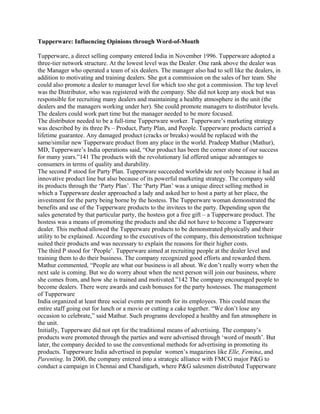
14804 tupperware case
- 1. Tupperware: Influencing Opinions through Word-of-Mouth Tupperware, a direct selling company entered India in November 1996. Tupperware adopted a three-tier network structure. At the lowest level was the Dealer. One rank above the dealer was the Manager who operated a team of six dealers. The manager also had to sell like the dealers, in addition to motivating and training dealers. She got a commission on the sales of her team. She could also promote a dealer to manager level for which too she got a commission. The top level was the Distributor, who was registered with the company. She did not keep any stock but was responsible for recruiting many dealers and maintaining a healthy atmosphere in the unit (the dealers and the managers working under her). She could promote managers to distributor levels. The dealers could work part time but the manager needed to be more focused. The distributor needed to be a full-time Tupperware worker. Tupperware’s marketing strategy was described by its three Ps – Product, Party Plan, and People. Tupperware products carried a lifetime guarantee. Any damaged product (cracks or breaks) would be replaced with the same/similar new Tupperware product from any place in the world. Pradeep Mathur (Mathur), MD, Tupperware’s India operations said, “Our product has been the corner stone of our success for many years.”141 The products with the revolutionary lid offered unique advantages to consumers in terms of quality and durability. The second P stood for Party Plan. Tupperware succeeded worldwide not only because it had an innovative product line but also because of its powerful marketing strategy. The company sold its products through the ‘Party Plan’. The ‘Party Plan’ was a unique direct selling method in which a Tupperware dealer approached a lady and asked her to host a party at her place, the investment for the party being borne by the hostess. The Tupperware woman demonstrated the benefits and use of the Tupperware products to the invitees to the party. Depending upon the sales generated by that particular party, the hostess got a free gift – a Tupperware product. The hostess was a means of promoting the products and she did not have to become a Tupperware dealer. This method allowed the Tupperware products to be demonstrated physically and their utility to be explained. According to the executives of the company, this demonstration technique suited their products and was necessary to explain the reasons for their higher costs. The third P stood for ‘People’. Tupperware aimed at recruiting people at the dealer level and training them to do their business. The company recognized good efforts and rewarded them. Mathur commented, “People are what our business is all about. We don’t really worry when the next sale is coming. But we do worry about when the next person will join our business, where she comes from, and how she is trained and motivated.”142 The company encouraged people to become dealers. There were awards and cash bonuses for the party hostesses. The management of Tupperware India organized at least three social events per month for its employees. This could mean the entire staff going out for lunch or a movie or cutting a cake together. “We don’t lose any occasion to celebrate,” said Mathur. Such programs developed a healthy and fun atmosphere in the unit. Initially, Tupperware did not opt for the traditional means of advertising. The company’s products were promoted through the parties and were advertised through ‘word of mouth’. But later, the company decided to use the conventional methods for advertising in promoting its products. Tupperware India advertised in popular women’s magazines like Elle, Femina, and Parenting. In 2000, the company entered into a strategic alliance with FMCG major P&G to conduct a campaign in Chennai and Chandigarh, where P&G salesmen distributed Tupperware
- 2. pamphlets and P&G’s Tempo tissues. The company held a cross-promotional exercise with P&G in 2001. The idea was that Pringle chips, which were being promoted by P&G, stayed crisp and crunchy when stored in Tupperware containers. Tupperware’s sales went up by 20% after this campaign. The ‘Caravan’ (a van that carried Tupperware products in road shows during festive seasons) and Tupperware ‘melas’ (display of Tupperware products in residential parks) were also introduced in 2001 to enhance awareness. Though direct selling remained its main revenue stream, Tupperware set up two kiosks at the Shoppers’ Stop outlets in Delhi and Mumbai in 2001, which were increased to 16 in 2002. Supporting the move, Kanwar S. Bhutani, who joined as the managing director of Tupperware India in 2000 said, “The move is aimed at lead generation (enhancing the recruitment set-up, in other words), upping brand awareness, and reaching out to potential customers unable to attend Tupperware Questions for Discussion: 1. How did Tupperware use parties to increase sales of its products? 2. “Tupperware’s marketing strategy was described by its three Ps – Product, Party Plan, and People.” What was unique about Tupperware’s marketing?
